ASRock FM2A88X Extreme6+ Review
by Ian Cutress on March 19, 2014 11:59 AM ESTSystem Benchmarks
Rightmark Audio Analyzer 6.2.5
The premise behind Rightmark:AA is to test the input and output of the audio system to determine noise levels, range, harmonic distortion, stereo crosstalk and so forth. Rightmark:AA should indicate how well the sound system is built and isolated from electrical interference (either internally or externally). For this test we connect the Line Out to the Line In using a short six inch 3.5mm to 3.5mm high-quality jack, turn the OS speaker volume to 100%, and run the Rightmark default test suite at 192 kHz, 24-bit. The OS is tuned to 192 kHz/24-bit input and output, and the Line-In volume is adjusted until we have the best RMAA value in the mini-pretest. We look specifically at the Dynamic Range of the audio codec used on board, as well as the Total Harmonic Distortion + Noise.
Dynamic Range for the ASRock FM2A88X Extreme6+
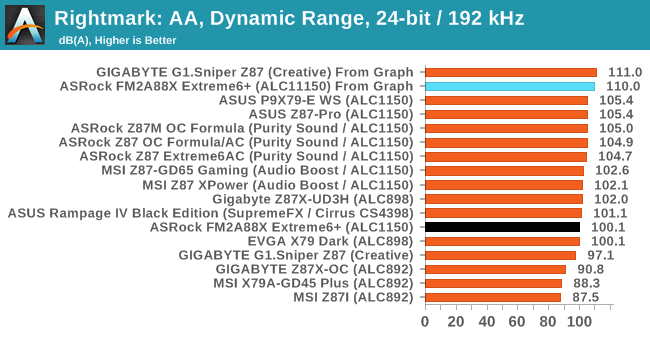
Despite the Realtek ALC1150 having a 115dB signal-to-noise rating, our RMAA test gave a result nearer 100. Within the 20 Hz – 20 kHz range of our SNR test, we see harmonic spikes at 100 Hz, 200 Hz and 300 Hz around 110 dB, making that our hearing range read-off value.
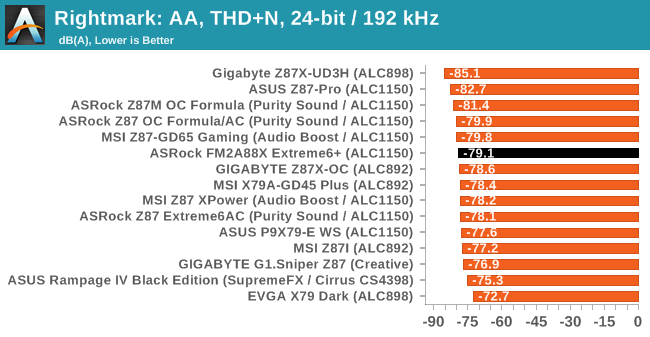
USB Backup
For this benchmark, we run CrystalDiskMark to determine the ideal sequential read and write speeds for the USB port using our 240 GB OCZ Vertex3 SSD with a SATA 6 Gbps to USB 3.0 converter. Then we transfer a set size of files from the SSD to the USB drive using DiskBench, which monitors the time taken to transfer. The files transferred are a 1.52 GB set of 2867 files across 320 folders – 95% of these files are small typical website files, and the rest (90% of the size) are the videos used in the WinRAR test. In an update to pre-Z87 testing, we also run MaxCPU to load up one of the threads during the test which improves general performance up to 15% by causing all the internal pathways to run at full speed.
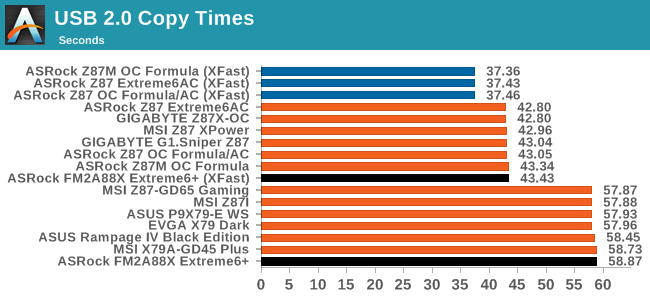
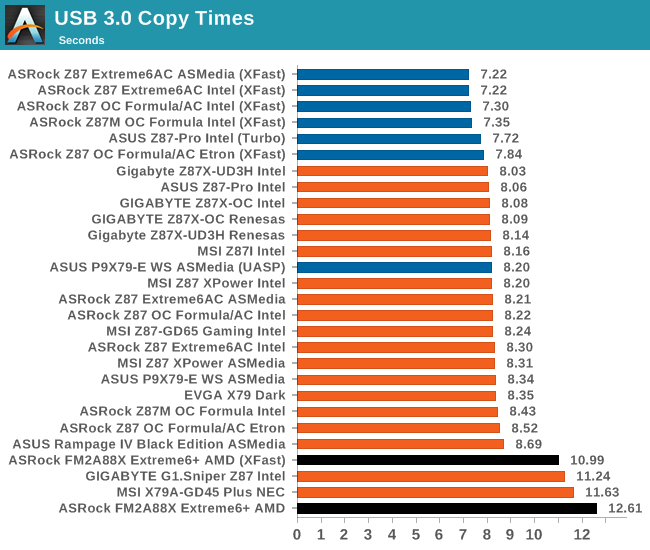
ASRock is still using its XFast software, which in our Windows 7 testing causes a significant shift in USB 2.0 performance. USB 3.0 also gets a ~13% speed-up.
DPC Latency
Deferred Procedure Call latency is a way in which Windows handles interrupt servicing. In order to wait for a processor to acknowledge the request, the system will queue all interrupt requests by priority. Critical interrupts will be handled as soon as possible, whereas lesser priority requests, such as audio, will be further down the line. So if the audio device requires data, it will have to wait until the request is processed before the buffer is filled. If the device drivers of higher priority components in a system are poorly implemented, this can cause delays in request scheduling and process time, resulting in an empty audio buffer – this leads to characteristic audible pauses, pops and clicks. Having a bigger buffer and correctly implemented system drivers obviously helps in this regard. The DPC latency checker measures how much time is processing DPCs from driver invocation – the lower the value will result in better audio transfer at smaller buffer sizes. Results are measured in microseconds and taken as the peak latency while cycling through a series of short HD videos - less than 500 microseconds usually gets the green light, but the lower the better.
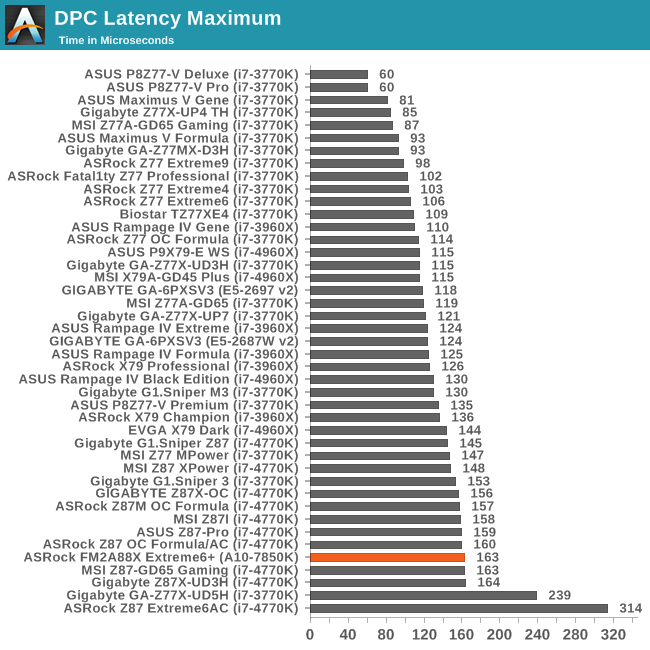
The A88X platform kicks off with a ~160 microsecond result in our DPC test, strangely matching most of our Intel 8-series results. We have another A88X motherboard in to test which also gets around the same result, suggesting that for lower peak DPC values, older platforms provide better results.











44 Comments
View All Comments
5thaccount - Thursday, March 20, 2014 - link
I know this isn't a review of the APU, but I'm very curious why it wasn't benched against a Celeron / i3 / i5 in the system and game benchmarks. I wouldn't expect this to come near i7 / Xeon territory (although, to it's credit, it did better than I was expecting). Was it only to strictly compare relative performance to the fastest Intel can provide? I'd be curious to see how it fared against similarly priced and cheaper Intel CPUs - especially in the game benchmarks.aike - Friday, March 21, 2014 - link
All the shock practice on the devices can be used keep on effort just by advantage about keeping effort or possibly at home process. All the devices undeniably construct over to any <a href="http://www.katalog.cc/">rolex replica</a> private??? lenses temperament, considering that it adds something to a?? lenses is visually and additionally trend.aike - Friday, March 21, 2014 - link
Genuinely, each one of on top of exploit fundamental purpose typically the copy wholesale handbags turned out to be some type of shrewd undermine concerning trendy finishing touches an increasing number of gals get to approve perhaps even booty.http://www.oakleafgardenmachinery.co.uk/superrepli...DrMrLordX - Saturday, March 22, 2014 - link
Thank you for taking the time to review this board, Mr. Cutress. I am curious about CPU throttling under heavy IGP load. Did you experience this problem? Some have attributed this to VRM temperatures, but others have observed that this may be related to a design decision on AMD's part to keep total power delivery to the chip within a specific TDP envelope, even when overclocking is present.I have been trying to figure out which AM2+ boards can mitigate or defeat this throttling behavior through UEFI settings. There is another way not involving the UEFI:
http://www.overclock.net/t/1459225/i-have-custom-l...
but it would be much nicer to tweak the UEFI to defeat this p5 state behavior. People with "good" cooling on the CPU and VRMs are still getting throttling, at least on some boards, some of the time . . . it's hard to nail down exactly who has this problem.